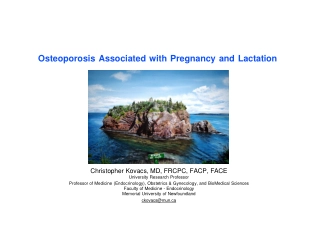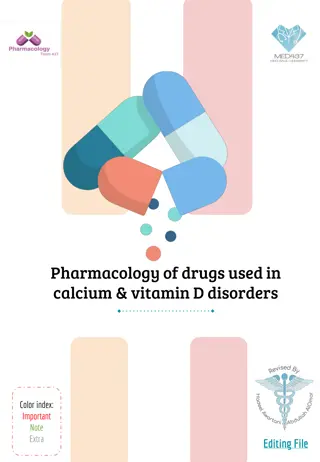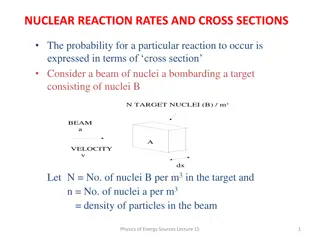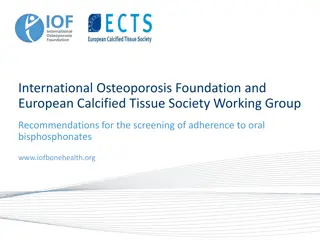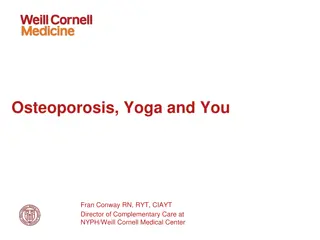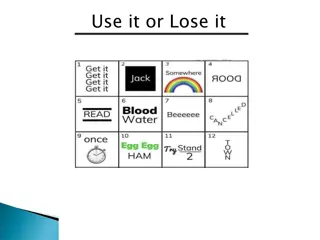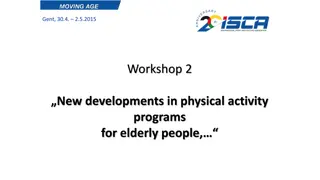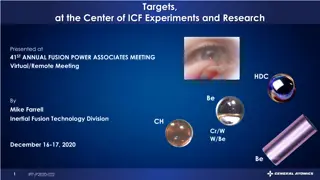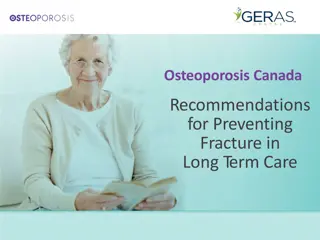
Treat to Target Strategy in Osteoporosis: Overview and Implementation
A comprehensive overview of the Treat to Target strategy in osteoporosis, including defining targets, potential markers, and common scenarios in therapy. Explore the validity of surrogate endpoints and post-setting goals for optimal patient management. Learn how this strategy is applied in various fields of medicine for improved patient outcomes.
Download Presentation

Please find below an Image/Link to download the presentation.
The content on the website is provided AS IS for your information and personal use only. It may not be sold, licensed, or shared on other websites without obtaining consent from the author. If you encounter any issues during the download, it is possible that the publisher has removed the file from their server.
You are allowed to download the files provided on this website for personal or commercial use, subject to the condition that they are used lawfully. All files are the property of their respective owners.
The content on the website is provided AS IS for your information and personal use only. It may not be sold, licensed, or shared on other websites without obtaining consent from the author.
E N D
Presentation Transcript
Treat to Target strategy in osteoporosis Hashemipour.s MD Endocrinologist Qazvin university of medical science
Agenda Definition Potential Targets Fracture BMD FRAX Bone markers Conclusion
Definition Setting a target (a surrogate) for the disease process and defining a level of that biomarker that should be reached for optimal protection against the detrimental effects of the disease
TTT is a feature of several fields of medicine Diabetes mellitus A1C < %7 : for preventing diabetes microvascular complications Hypertension BP<140/90: for preventing cardiovascular complications Rheumatoid Arthritis Score of clinical and inflammatory laboratory parameters
Validity of surrogate endpoint Correlation alone would not be enough Proper justification requires that the effect of the intervention on the surrogate end point predicts the effect on the clinical outcome a much stronger condition than correlation
Post setting goal Selecting a drug or combination of drugs to reaching the target Once the target for blood pressure, or A1C has been reached, the same treatment is usually continued unless an adverse effect is recognized When the underlying disease becomes less severe, as might occur with changes in diet, weight, or physical fitness, the dose or type of medication may require adjustment In the face of failure to reaching target , changing treatment
Common scenario Starting therapy: once a decision has been made to treat a patient with a pharmacologic agent, a first-line drug, usually an oral bisphosphonate, is prescribed BMD is often repeated 1 to 2 years later to evaluate Response to therapy :Stabilization or improvement of BMD is usually accepted as validation that the patient is responding appropriately to treatment
Common scenario (cont) Follow up: The same treatment is then continued; after 3 to 5 years of oral or intravenous bisphosphonate therapy, a bisphosphonate holiday may be considered. Treatment failure: If there is a statistically significant decline in BMD 1 to 2 years after starting therapy, clinicians evaluate for secondary causes and consider switching to a different agent
Treat to target strategy A goal of treatment is established for a patient the initial choice of treatment is based on the probability of reaching the goal progress toward reaching the patient s goal is reassessed periodically, with decisions to stop, continue, or change treatment based on achievement or progress toward goals Cummings et al. JBMR. 2017,32: 3 10
Ideal surrogate (target) Evidence-based Simple Widely available Inexpensive Understandable for physicians and patients Applicable for men and women of all ethnicities worldwide
Potential targets Fracture BMD FRAX probability Bone turnover markers
Potential targets Fracture BMD FRAX probability Bone turnover markers
Occurrence of fracture as treatment failure?
Fracture Available treatments reduce fracture incidence by 30 to 50 %, it is to be expected that fractures will occur on treatment Treatment failure in osteoporosis. Osteoporos Int,2012, 23:2769 74
Multiple fractures in FIT trial J Am Geriatr Soc, 2002. 50:409 415
Fracture There is currently no widely used definition of treatment failure, though the occurrence of two or more incident fractures in a treated patient may be an indication that the patient is not responding to treatment (based on 70- 90% fracture prevention in clinical trials) Treatment failure in osteoporosis. Osteoporos Int,2012, 23:2769 74
Important note Fractures of the hand, skull, digits, feet and ankle are not considered as fragility fractures Falls are an important driver of fracture. Therefore this problem should be considered when analysing response to treatments Treatment failure in osteoporosis. Osteoporos Int,2012, 23:2769 74
Fracture during treatment? Residual risk Changes in risk factors, for example, those not influenced by the current treatment, such as falls problem with compliance Suboptimal or failed treatment; indicating the need for a modification of the management strategy
Forget Fracture as a Target It does not appear to be realistic to apply the occurrence of incident fracture in a treat-to-target strategy Goal-directed treatment of osteoporosis in Europe. Osteoporos Int. 2014 Sep 9. [Epub ahead of prin.
Potential targets Fracture BMD FRAX probability Bone turnover markers Indices of bone strength
RR of Fx for 1 SD decrease in BMD (age-matched) Site Hip Fx vertebral Fx Distal radius 1.8 1.7 Proximal radius 2.1 2.2 Calcaneous 2.0 2.4 Spine 1.6 2.3 Femoral neck 2.6 1.8 (marshall D,et al,BMJ. 1996:,312:1254)
What about BMD in patients under anti-osteoporosis treatment?
Meta-analysis of all randomized, placebo- controlled trials of antiresorptive agents conducted in postmenopausal women with osteoporosis To examine the extent to which increases in BMD and reductions in BCM during antiresorptive therapy are associated with reductions in risk of non vertebral fractures J Clin Endocrinol Metab 87: 1586 1592, 2002
Treatments with the largest increases in lumbar spine BMD at 1 yearr, 6% vs. placebo, are associated with a 39% reduction in non vertebral fracture risk
Treatments with the largest increases Hip BMD at 1 yr, 3% vs. placebo, are associated with a 46% reduction in non vertebral fracture risk
A post hoc analysis of FLEX trial To determine whether the effect of long term ALN on fracture differs by vertebral fracture status and femoral neck (FN) T-score Journal of Bone and Mineral Research, Vol. 25, No. 5, May 2010, pp 976 982
Continuing ALN for 10 years instead of stopping after 5 years reduces NVF risk in women without prevalent vertebral fracture whose FN T-scores, achieved after 5 years of ALN, are - 2.5 or less but does not reduce risk of NVF in women whose T-scores are greater than -2
A subgroup analysis of HORIZON PFT study (An extension RCT of the HORIZON study ) To determine if continuing ZOL reduces fracture risk in subgroups
Difference of morphometric vertebral fracture rate based on total and neck femur BMD
Key message In patients treated with bisphosphonates, femoral neck or total hip BMD at 3-5 years after treatment can predict fracture after drug discontinuation (as drug holiday)
Relationship of BMD changes and fracture rate is not consistent in different studies
Drug Increase in spine BMD Decrease in vertebral Fx (Trial) Alendronate (FIT ll) Alendronate (FIT l) Residronate (RVE) %8.3 %7.9 %7.1 %44 %47 %49 Residronate (RVN Raloxifen (MORE) %5.4 %2.6 %41 %40 Calcitonin(PROOF) %1.2 %36
Fracture Intervention Trial : 6,459 women were randomly assigned to treatment with alendronate or placebo To compared reductions in risk of spine fractures at end of follow-up (3 or 4 years) within various levels of change in total hip and spine BMD after 1 and 2 years of treatment Osteoporos Int (2005) 16: 842 848
Risk of vertebral fracture as a function of total hip BMD loss at 1 year
A post hoc analysis, combined data from three pivotal risedronate fracture endpoint trials Women received risedronate 2.5 , 5 mg (n=2561) or placebo (n=1418) daily for up to 3 years BMD and non vertebral fractures confirmed by radiograph (hip, wrist, pelvis, humerus, clavicle, and leg) were assessed periodically over 3 years J Bone Miner Res 2005;20:2097 2104.
LS changes FN changes
Changes in BMD as measured by DXA do not predict the degree of reduction in non vertebral fractures Incidence of non vertebral fracture HR LS Increase 6.4% 0.79; 95% CI, (0.50,1.25) LS decrease 7.8% 1 FN Increase 7.5% 0.93; 95% CI,( 0.68, 1.28) FN Decrease 7.6% 1
Advantages T-scores are used for diagnostic classification and to determine when treatment is indicated In most studies increase in BMD is associated with reduction in fracture risk DXA is widely available and currently used to monitor therapy Physicians and patients are already generally familiar with T-scores
Potential limitations No change in BMD (or even loss of BMD in some studies) with therapy is also associated with reduction in fracture risk
Potential limitations BMD values vary with different instruments and at different skeletal sites and changes with changed database Even wit using the same instrument and same skeletal site, Precision error of BMD is higher than BMD attainment in many subjects. It is not clear to use 95% confidence interval or lower amounts(eg 80% CI) for detecting suboptimal response of BMD to treatment An absolute target may not attainable when the baseline fracture risk is very high
Potential targets Fracture BMD FRAX probability Bone turnover markers
Validated Risk Factors Advanced age Previous fracture Family history of hip fracture Long-term glucocorticoid therapy Low body weight (less than 58 kg [127 lb]) Cigarette smoking Excess alcohol intake
Objective: To confirm (or refute) the clinical utility of using change in FRAX scores over time as a surrogate measure that could be used to inform goal directed therapy and thus guide decisions around initiation and duration of osteoporosis treatment 11,049 untreated women aged 50 years undergoing baseline and follow up DXA examinations in Manitoba, Canada were evaluated Median interval between two DXA was 4 years and for median of 4 years were followed for incident fracture Journal of Bone and Mineral Research, Vol. 29, No. 5, May 2014, pp 1074 1080

